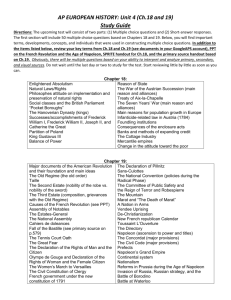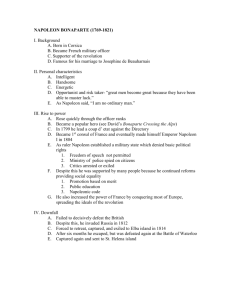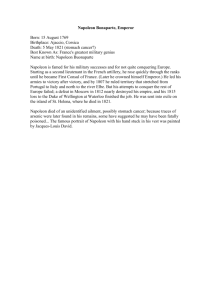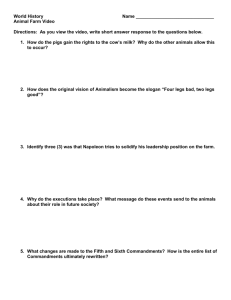Classical Art
advertisement
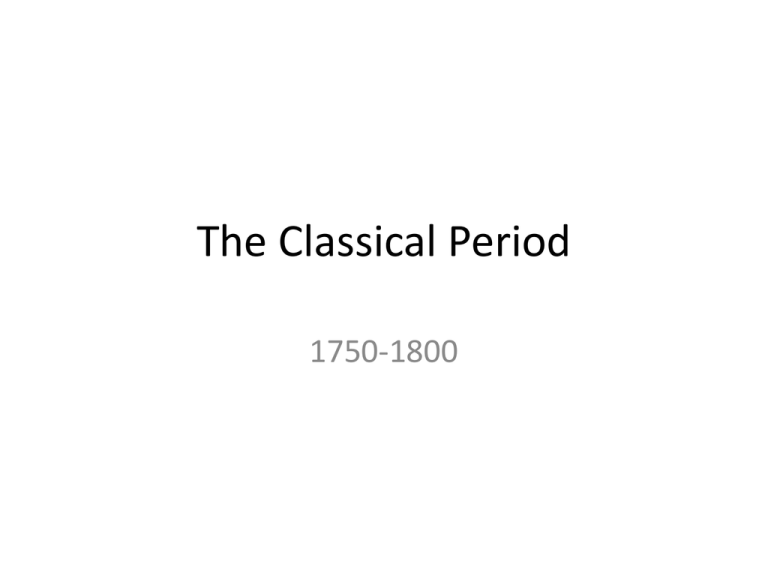
The Classical Period 1750-1800 Influences in Art • As the Rococo marked the end of an era of opulence and excess; Neoclassicism marked a return to rational principles • Attention once again shifted to the classic ideals of the Greeks and Romans • The French Academy (founded in the 17th) century, was regarded as the guardian and purifier of French intellectual life – Controlled art and education – Set “official” standards of taste and style – Protested against the superficial elegance of the Rococo and sponsored a return to classic ideals based on Greek and Roman models – The movement gained momentum at the time of the Revolution, as the public denounced anything representative of the French aristocracy Style • Expressed classic ideals using models from Greece, Rome and the Italian Renaissance • Encouraged forms that were realistic and stripped of sentimentality • Art became a symbol of detachment from superficial feeling Interior of the Pantheon, Giovanni Paolo Panini (cp 11) • Uses classic subject, the Pantheon in Rome • Humans are presented as inconsequential figures; focus is on the classic features of the Pantheon • Dramatic linear perspective • Beam of light created by the opening in the dome (oculum) Oath of the Horatii Jaques Louis David • David was the leader of the Neoclassical movement in France. He visited Greece and Rome, returning with enthusiasm for the ancient cultures • Oath of the Horatii was painted four years before the French Revolution • Subject is a Roman father pledging his three sons to fight against the enemies of Rome – Reflects an admiration for the virtue of fighting for liberty • Style and forms reflect Renaissance classicism – Lines are sharply defined, severe and angular—convey great strength – Separate groups make up the whole • Three sons, father, weeping women – Swords are the focal point and placed exactly in the center – Each group framed against Roman arches set on Greek columns – Little expressive feeling, despite the subject matter Napoleon Crossing the Saint Bernard, Jacques Louis David • • • • David was an admirer of Napoleon; likewise Napoleon held David in high esteem Napoleon commissioned David to commemorate his crossing of the Alps, which allowed the French to surprise the Austrian army and win the Battle of Marengo Napoleon had really crossed the Alps on a mule, but requested to be portrayed “calm on a fiery steed” After being named emperor of France in 1804, Napoleon named David the official court painter of his regime Death of Marat, Jacques Louis David • • • • • Marat was a political leader, responsible for many events of the Revolution He was killed by Charlotte Corday, who entered under the false pretense of giving him a list of anti-Revolutionaries. When he accepted her list and thanked her, she stabbed him Shown in a bathtub, as he had a skin condition that caused him to itch horribly. He spend a lot of time in the bathtub, as it was his only form of relief David organized a spectacular funeral and Marat was buried in the Pantheon Immortalized Marat as a martyr of the revolution Portrait of a Young Woman, called Mlle. Charlotte duVal d’Ognes (cp 45) • • • • Mistakenly attributed to David for many years Artist is Constance Marie Charpentier Realistic in its details Sharp lines reflect a style very different from Baroque and Rococo • Lack of detail in the room draws attention to Mlle. Val d’Ognes—details of her face, hair, clothing Death of General Wolfe (cp 47) • Benjamin West – – – – Began training in Philadelphie, but studie in Italy and settled in England Close friend of King George III Teacher of many American painters Often painted historical subjects • Portrays the death of General Wolfe at the siege of Quebec during the French and Indian War • Characters in contemporary dress, but in classical poses and arrangemet • Inclusion of the Indian coneects the event to the New World • Figures arranged in groups, drawing the eye toward the dead general in the center • Lighting also focuses attention toward general • Burning city in the background contrasted with darkness on the right Antonio Canova • Used similar forms to classic Greek and Roman sculpture • Pauline Borghese as Venus (p. 226) – Commissioned by Pauline Borghese (Napoleon’s sister) – Appears to resemble classic form, but does not portray the Greek ideal of beauty Cupid and Psyche Napoleon as Mars the Peacemaker • • • • • Presents Napoleon as idealized Greek form Closed form Holds Nike in his right hand – represents victory Completed in 1806, when it was sent to the Musee Napoleon Napoleon refused the sculpture, stating that it was “too athletic”
